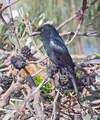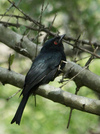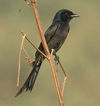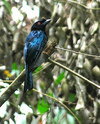Genus Dicrurus
Fork-tailed Drongo - The Fork-tailed Drongo is a common and widespread resident breeder in Africa south of the Sahara. These insect-eating birds are usually found in open forests or bush. Two to four eggs are laid in a cup nest in a fork high in a tree.
Bronzed Drongo - The Bronzed Drongo is a small Indomalayan bird belonging to the drongo group. They are resident in the forests of South Asia and Southeast Asia. They are very similar to the other drongos of the region but are somewhat smaller and compact with differences in the fork depth and the patterns of gloss on their feathers.
Aldabra Drongo - The appearance of this species is typical for drongos, with entirely black plumage, a heavy bill and a red eye. The tail is long and forked. Juvenile birds have a grey back, lighter blotched undersides and a brown eye. Its call is a harsh chuckle.
Andaman Drongo - The Andaman Drongo is 28–29 cm long, although the larger dicruriformis subspecies is 35 cm in length. It has a deeply forked tail and a heavy black bill. The plumage is black , and glossed with green. There is some sexual dimorphism, with the female being smaller and having a less forked tail.
Crow-billed Drongo - The Crow-billed Drongo is a species of bird in the Dicruridae family. It is found in Bangladesh, Bhutan, Brunei, Cambodia, China, India, Indonesia, Laos, Malaysia, Myanmar, Nepal, the Philippines, Singapore, Thailand, and Vietnam. Its natural habitats are subtropical or tropical moist lowland forests and subtropical or tropical mangrove forests.
Balicassiao - Its natural habitat is subtropical or tropical moist lowland forests.
Spangled Drongo - The Spangled Drongo is the only Drongo to be found in Australia. "Drongo" is Australian slang for "idiot", possibly referring to the bird's uninhibited and sometimes comical behaviour as it swoops and perches in search of insects, small birds and occasionally, small skinks.
White-bellied Drongo - Balicassius caerulescens Buchanga caerulescens
Wallacean Drongo - Its natural habitats are subtropical or tropical moist lowland forests, subtropical or tropical mangrove forests, and subtropical or tropical moist montane forests.
Comoro Drongo - Its natural habitats are subtropical or tropical moist lowland forests, pastureland, and plantations. It is threatened by habitat loss.
Hair-crested Drongo - This species was formerly considered conspecific with Dicrurus bracteatus, for which the name "Spangled Drongo" is now usually reserved. Some authorities consider it conspecific with the Sumatran Drongo .
Ashy Drongo - The adult Ashy Drongo is mainly dark grey, and the tail is long and deeply forked, There are a number of subspecies varying in the shade of the grey plumage. Some subspecies have white markings on the head. Young birds are dull brownish grey.
Square-tailed Drongo - The Square-tailed Drongo is a common resident breeder in much of Africa south of the Sahara. These insect-eating birds are usually found in forests or dense bush. Two to three eggs are laid in a cup nest in a fork high in a tree.
Black drongo - Buchanga atra Bhuchanga albirictus
Sulawesi Drongo - Its natural habitats are subtropical or tropical moist lowland forests and subtropical or tropical moist montanes.
Greater Racket-tailed Drongo - The Greater Racket-tailed Drongo, Dicrurus paradiseus, is a medium-sized Asian bird which is distinctive in having elongated outer tail feathers with webbing restricted to the tips. They are placed along with other drongos in the family Dicruridae. They are conspicuous in the forest habitats often perching in the open and by attracting attention with a wide range of loud calls that include perfect imitations of many other birds. It has been suggested that these imitations may help in the formation of mixed-species foraging flocks, a feature seen in forest bird communities where many insect feeders forage together. These drongos will sometimes steal insect prey caught or disturbed by other foragers in the flock. They are diurnal but are active well before dawn and late at dusk. Owing to their widespread distribution and distinctive regional variation, they have become iconic examples of speciation by isolation and genetic drift.
Lesser Racket-tailed Drongo - It is found in Bangladesh, Bhutan, Cambodia, China, India, Indonesia, Laos, Malaysia, Myanmar, Nepal, Thailand, and Vietnam. Its natural habitat is subtropical or tropical moist montane forests.
Sumatran Drongo - Its natural habitat is subtropical or tropical moist lowland forests. It is threatened by habitat loss.
Mayotte Drongo - Its natural habitats are subtropical or tropical moist lowland forests, subtropical or tropical mangrove forests, subtropical or tropical moist shrubland, and plantations . It is threatened by habitat loss.








